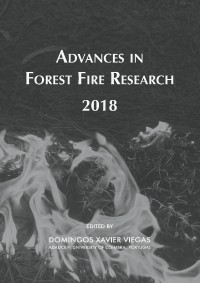Please use this identifier to cite or link to this item:
https://hdl.handle.net/10316.2/44580| Title: | Multi-scale modeling of the thermal degradation of woods | Authors: | Gerandi, Guillaume Tihay-Felicelli, Virginie Santoni, Paul-Antoine Leroy-Cancellieri, Valérie Cancellieri, Dominique |
Keywords: | Fuel degradation;multi-scale;fire model input | Issue Date: | 2018 | Publisher: | Imprensa da Universidade de Coimbra | Journal: | http://hdl.handle.net/10316.2/44517 | Abstract: | The modeling of the mass loss rate of vegetation is a key feature in models of forest fire as it allows quantifying the source term of combustible gases that supply the flames. In this work, we investigated the thermal degradation of two woods (oak and eucalyptus) using a multi-scale approach. At matter scale, experiments were carried out with a thermogravimetric analyser (TGA) under oxidizing atmosphere at several heating rates. We focussed on temperatures ranging from 150°C to 650°C in order to avoid the effect of the desication of free water and to consider only the thermal degradation of dry wood. Three kinetic mechanisms of degradation, each one consisting of four steps were developed by using the thermogravimetric results. The first one is based on an approach by constituents, the second one follows a lumped approach and the third one takes into account the formation of “active wood” which corresponds to a reduction in degree of polymerization. The kinetic parameters were calculated for each mechanism by using a genetic algorithms method. The lumped approach proved to be the mechanism that best represents the thermal decomposition of both woods. It was then tested at the material scale in the case of thermally thin wood plates heated with two radiant heat fluxes of 20 and 25 kW/m². These experiments were carried out with a cone calorimeter. The radiant heat flux was imposed at the top of the fuel sample. The mass loss rate was recorded as well as the temperature at the back surface of the wood, which was assumed equal to the temperature of the whole plate. For a radiant heat flux of 20 kW/m², the lumped approach predicted a mass loss close to the experimental results for temperatures lower than 400°C. Above this threshold, the prediction underestimated the mass loss. Then, for a radiant heat flux of 25 kW/m², the lumped approach did not allow predicting correctly the thermal degradation of the plate. For such radiant heat fluxes, the temperature gradient within the plate has to be taken into account to test the kinetic mechanisms of degradation at material scale. | URI: | https://hdl.handle.net/10316.2/44580 | ISBN: | 978-989-26-16-506 (PDF) | DOI: | 10.14195/978-989-26-16-506_63 | Rights: | open access |
| Appears in Collections: | Advances in forest fire research 2018 |
Files in This Item:
| File | Description | Size | Format | |
|---|---|---|---|---|
| multi-scale_modeling_of_the_thermal_degradation.pdf | 1.09 MB | Adobe PDF |  |
Items in DSpace are protected by copyright, with all rights reserved, unless otherwise indicated.
